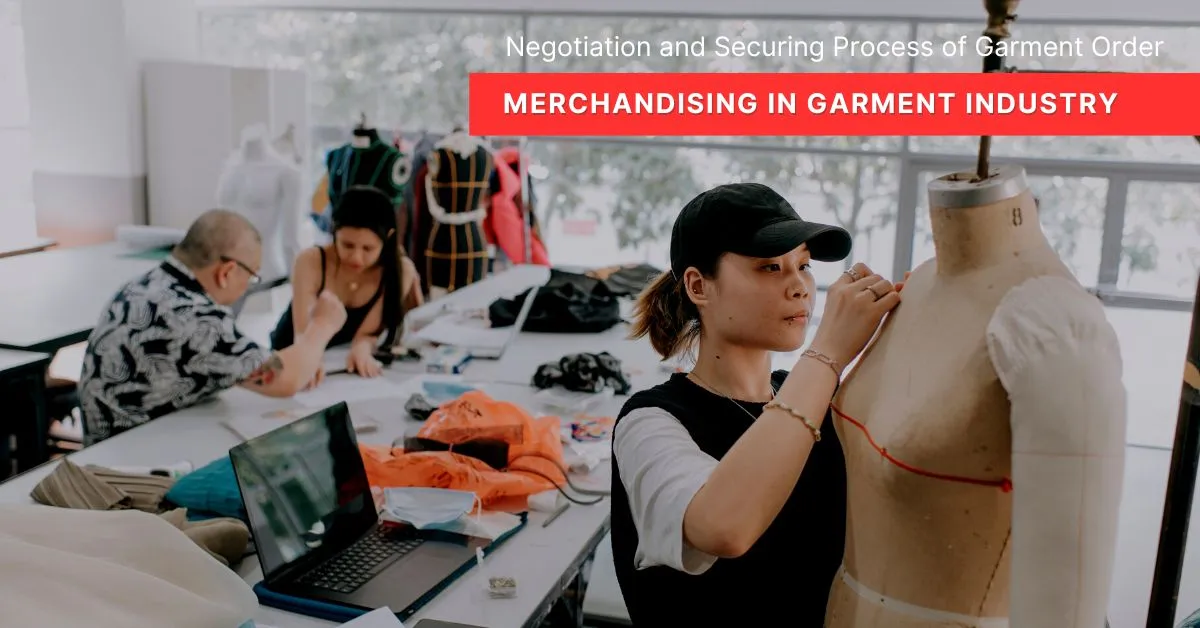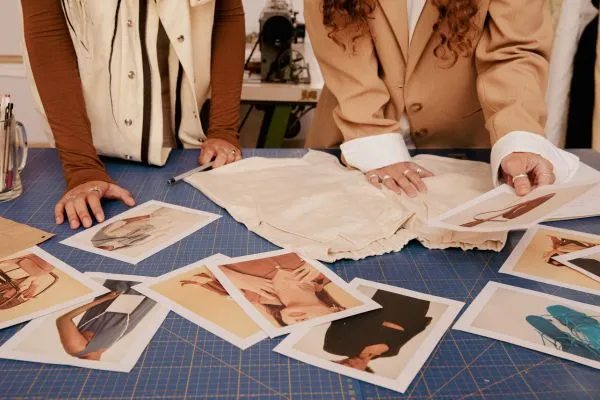Merchandising in garments refers to the procedure of communication and discussion which occurs between two parties: buyer and merchandiser (on behalf of the factory) about a garment order’s price, quality, style, lead time, order volume etc.
In merchandising in garment industry’s negotiation process, each party represents their own demands. The buyer always has a budget price for the merchandise to buy the product. They will always try to buy the products at a lesser price from their target. On the other hand, the merchandiser will always try to increase the price to earn maximum profit.
Most of the time merchandising in garment industry argument ends up with a win-win situation for both parties. Thus, the buyer secures the order through fair negotiation. The main purpose of negotiation is to make a final decision where the decision will be accepted by both parties. For a fruitful negotiation, a merchandiser should have a proper idea about the product and pricing.
Table of Contents
Merchandising process in garment industry
Merchandising is a process through which products are designed, developed, manufactured and presented to the buyer. It mediates the marketing and production department. It includes directing and supervision of the development of the production line from design to shipment.
| Step | Activity | Description |
|---|---|---|
| 1 | Market Research | Conduct market research to identify current fashion trends, customer preferences, and competitor analysis. |
| 2 | Product Development | Collaborate with design and production teams to develop new garment styles based on market research findings. |
| 3 | Costing and Pricing | Calculate the production cost of each garment, including materials, labor, and overhead. Determine the retail price. |
| 4 | Sample Development | Create samples of the designed garments for approval by buyers and for quality testing. |
| 5 | Order Placement | Receive orders from buyers and negotiate terms, including quantity, delivery schedule, and payment terms. |
| 6 | Production Planning | Plan production schedules, coordinate with manufacturers, and ensure timely production of the ordered garments. |
| 7 | Quality Control | Implement quality control measures to ensure that the manufactured garments meet the specified standards. |
| 8 | Shipment Coordination | Coordinate the logistics and shipment of finished goods to the buyer’s location, ensuring on-time delivery. |
| 9 | Documentation and Compliance | Prepare and manage all necessary documentation, including invoices, packing lists, and compliance with regulations. |
| 10 | Communication with Buyers | Maintain regular communication with buyers, providing updates on order status, addressing concerns, and obtaining feedback. |
| 11 | Inventory Management | Monitor and manage inventory levels to ensure availability of products and prevent overstock or stockouts. |
| 12 | Sales and Marketing Support | Work with the marketing team to create promotional materials and support sales efforts to maximize product visibility. |
| 13 | Post-Sales Support | Provide post-sales support, address customer complaints, and handle returns or exchanges as necessary. |
A merchandiser is responsible for executing the orders perfectly. Such as the costing and pricing. For these, an apparel merchandiser must analyze buyer requirements and follow their behaviors to sell the garments merchandise.
There are different types of garments merchandise, and a merchandiser has different types of tasks to deal with. A prior task they must perform is negotiating with buyers and securing the order. The negotiation process has to be done with great importance and expertise as conformation of the order totally depends on it.
It’s not always simple to negotiate an order between a buyer and a manufacturer. Price, delivery, quota, and other issues are discussed for orders that have been delivered to factories. The manufacturers are continuously aiming to earn at least 2% more than what they received last time for the similar style while the buyers are continuously trying to get these manufactured items at very low prices.
Every buyer is constantly trying to get these manufactured items at very low prices. Every buyer has a target price in mind for the goods they want to purchase. They are completely aware of the going rate for the specific kind of clothing as they do some homework before approaching. He will therefore try his utmost to purchase the clothing below or at his goal price.
A merchandiser must not disregard the abundance of producers and suppliers around the world. If he can’t meet the customer’s pricing, the buyer will undoubtedly look for another source. Securing the order is a prior task for a merchandiser. Proper negotiation with the consumer plays a very important role here.
So, a merchandiser will have to guarantee top quality and on time delivery in an effort to persuade customers to pay an extra dollar for their products. It can be challenging to persuade a buyer to pay more than his target price, but it might be achievable if the seller and the customer get along well or if the seller has a solid reputation for high quality work.

So, after receiving the order a merchandiser has to go through various processes to secure the order. For this, he produces a BOM sheet and provides it to the buyer. Negotiates about price and then creates the pre-production sample to provide the buyer.
Performing these tasks perfectly can secure the order and helps in the negotiation process. Rest of the order or future orders in this factory from the buyer depends on the negotiation and other activities done by the merchandiser to secure the order. That’s why negotiation plays a very important role in garment orders.
Role of merchandiser in garment industry
In the dynamic world of the textile industry, the role of a merchandiser stands out as both crucial and demanding. This behind-the-scenes maestro is responsible for steering various aspects of the business, from design conception and manufacturing to sourcing, sales, and retail display. Let’s delve into the key facets of a merchandiser’s role in the garment industry through a simplified listicle:
1. Multifaceted Responsibilities:
Merchandising involves planning and coordinating the whole process of developing a product line. Foreign customer orders are handled by merchandisers. Teams are formed based on the buyers being served. A merchandiser must have excellent negotiation and communication skills as well as visual and analytical capabilities. Additionally, he or she must be a creative and original thinker.
- Design Development: Transforming designs into marketable and producible products.
- Manufacturing Execution: Overseeing the entire production process to ensure viability.
- Sourcing: Identifying and securing the necessary materials, including fabrics and accessories.
- Customer Sales: Interacting with buyers, negotiating terms, and addressing client needs.
- Retail Store Display: Ensuring that products are presented attractively in retail settings.
2. Essential Skills of a Merchandiser:
Merchandisers should have some essential skills. He must have knowledge about current market trends, predicting upcoming fashion trends, and evaluating technical factors like fabric and trimming-accessories details and apparel quality. They also require coordination and communication with relevant industry stakeholders. Merchandisers take designs and develop them so that they will be marketable, producible, and satisfy customer demands.
- Market Knowledge: Staying informed about current trends and predicting future fashion shifts.
- Technical Expertise: Evaluating fabric, trimmings, and apparel quality.
- Coordination: Collaborating with industry stakeholders for seamless operations.
- Communication: Maintaining effective communication channels with buyers and other parties.
- Creativity: Being a creative thinker to adapt designs for marketability and production feasibility.
3. Integral Role in Commerce:
A merchandiser does analysis of markets and products, promoting the idea and developing the product. Along with designing, a merchandiser does the sampling and negotiation to assure the order from the buyer. Later he gives booking of the raw materials (Fabrics, trims and accessories) and maintains communication and proper follow-up.
- Buying House Dynamics: Playing a crucial role in the buying house, where a significant portion of fashion commerce occurs.
- Commercial Viability: Ensuring that the entire process is commercially and productionally viable.
- Client Satisfaction: Tailoring products to meet client demands and expectations.
4. Process Overview:
Sometimes the exporter receives the order straight from the buyer. However, the buying house is where around 60–70% of the whole commerce for fashion items is conducted. The merchandiser is crucial to this entire process & creates it in a way that will make it commercially and productionally viable and satisfy client wants.
- Market and Product Analysis: Conducting in-depth analysis to inform product development.
- Promotion and Development: Promoting ideas and actively contributing to product development.
- Sampling and Negotiation: Handling the crucial stages of sampling and negotiating with buyers.
- Raw Material Management: Initiating the booking of raw materials and overseeing communication.
- Production Oversight: Monitoring the bulk production process after sample and color approval.
After different garment samples and color approval, production starts in bulk as per the purchase order. The merchandiser then gives guidance and supporting production, advising the quality department on the degree of quality. He provides shipment instructions and ensures delivery, aiding the department of documentation, assuming charge of inspections and keeping track of the cargo.
In essence, the merchandiser is the linchpin that transforms creative concepts into tangible garments ready for the market. With a blend of analytical prowess, negotiation skills, and a dash of creativity, these industry wizards orchestrate the intricate dance that brings fashion from the drawing board to the consumer’s closet.
In the textile industry, the merchandiser’s job is both important and challenging. At various levels of the business, a merchandiser’s responsibilities include design development, manufacturing execution and sourcing, customer sales, and retail store display.

Process flow chart of merchandising in garments industry
Receiving orders from buyer with details
↓
Developing the design
↓
Send the design to produce buyer sample
↓
Negotiate the garments pricing with the Buyer’s representative
↓
Receiving the order sheets with confirmation of order
↓
Production of the buyer requirement samples like Fit sample, Proto sample etc.
↓
Place requisition for bulk fabric
↓
Place requisition for accessories
↓
Create Swatch board for approval
↓
Source raw materials and receive it in factory
↓
Quality Control
↓
Produce pre-production Sample with all actual
↓
Arrange Pre-production meeting
↓
Initiate bulk production
↓
Update the daily production and quality report from factory
↓
Sample sent to third party testing lab
↓
Arrange final inspection
↓
Shipment
↓
Receive payment from Bank
Garment order securing and confirmation
However, the primary job of the merchandiser is to confirm the order before he starts to execute the process. For the confirmation, the merchandiser needs to follow the steps below:
- Researching information, communication and inquiry of product
- Identifying vendors/ suppliers
- Tracking and observing trends, and being aware of the buyers’ market
- Development of the product
- Costing and Negotiation
- Placement of the order
- Researching information, communication, and inquiry of product
Merchandisers have to communicate with different levels of people. Such as existing buyers for the follow- up for orders in hand, new buyers for potential future business. There are several modes of communication like email, video conference, visual meetings etc. The merchandise manager must contact the buyer representative and send their company profile.
A merchandiser must assure the buyer representative of making a buyer required sample. Offer their block pattern or sample or collect the product from the buyer and inquire about the product including all technical issues.
Besides this, merchandisers should make a swatch card. Then take buyer approval and bill of material sheet with rough consumption for sourcing material suppliers.
1. Identifying suppliers
Merchandiser plays the role as the bridge between the manufacturer and buyer. He needs to maintain proper coordination with the vendors. Merchandisers need to maintain total supply and demand synchronization. It could be done properly by Technical data interchanges among the parties involved in providing the customer service (Supplier, Distributor, and Logistics Operator). All parties must have the quality to provide the end customer with the greatest value, best service and maximum variety of products.
2. Tracking and observing fashion trends, and being aware of the buyers’ market
In addition to adhering to the export order, the merchandiser must also be informed of current market trends in terms of fabric, color, patterns, style, and designs, among other things and do forecasting of upcoming fashion trends in the market (be ready to develop the new style as per the season. The merchandiser must require that new concepts, designs, and styles be developed by an internal design studio (if one is available) or a product development team.

When a customer visits a factory, the merchandiser can display new advancements, such as desk looms, lab-dips, strike-offs, and freshly created garment designs, in front of the customer or send them to the customer’s office for selection.
For certain designs, the merchandiser needs to be persuasive in order to win over the customer
3. Development of the product
Product development has evolved into the organization’s official business strategy since merchandisers serve as a conduit between consumers and manufacturers. They may ascertain consumer market knowledge and inform new product creation appropriately.
Proto sample is the first and foremost sample. It is made at the initial stage. Sometimes it is made of available fabric with trimmings and accessories, and the vice versa is true. Vendor makes a recap sample after getting comments on the proto sample.

Some companies have an internal design studio or design development section, and exporters seasonally generate designs. These designs must be created as examples and presented to the customer. The development of designs, the availability of fabrics and trimmings for them, and the tracking of development samples are all handled by the Product Development merchandiser. Some businesses occasionally produce their own fabrics; thus the merchandiser also monitors fabric development in those cases.
4. Garments Costing and Negotiation
The merchandiser’s principal function is to calculate costs. Only costs are determined and offered to buyers throughout the product development and sample stages. The costing of garments is a essential task for merchandisers, especially in soft line. Overall chance of getting orders and profit depends on it simultaneously. Usually, pricing is an attempt to calculate the total cost of production of finished apparel. Costing is done considering below parameters:
- Cost of all raw material including trimming and accessories like fabric, accessories, packaging items
- Cost of production (CM)
- Cost of finishing such as printing, washing, embroidery, heat-seal, and so on.
The function of negotiation is not to push the other party to defeat rather than work out a win-with solution. Therefore, both parties (Buyer and manufacturer) can transact business with profit. Then Orders that have been sent to factories will be negotiated for price, delivery date, quota and quality and so on. The buyer always has a target price for the merchandise he hopes to source the garments.
In contrast, producers will guarantee top quality and quick delivery in an effort to persuade customers to pay an additional dollar or two for their products. It can be challenging to persuade a buyer to pay more than his goal price, but it can be achievable if the seller and the customer get along well or if the seller has a solid reputation for high-quality work.
5. Placement of the order
Most of the buyer do the order confirmation after fair bargaining. The buyer or buyer representative do many stages of sampling in comparison to other manufacturer. Buyer confirms the order via providing the master LC (Letter of credit) or T/T to the vendor. Garment costing and sampling are very important for clinching orders defeating the manufacturer competitors. Payment is determined via some ways like: Letter of credit known as L/C) or Foreign currency account – F.C.A is required to do the task smoothly. The US Dollar is the currency to exchange remittance in international business.
Finally, when the order is confirmed, and the buyer provides the purchase order to the buying house or manufacturer. Purchase order form consists of specific style name, fabrics construction, yarn count, GSM, accessories, layout of trims, carton measurement etc. After the order is confirmed, further follow up and execution of the process is carried out by the merchandiser.
Conclusion
Negotiation is the key competency of a merchandiser. In the negotiation process, they should follow these five stages –
- Investigation
- Determining BATNA (Best Alternative to a Negotiated Agreement)
- Presentation
- Bargaining &
- Closure
It is called bargaining because it is the process of communication & trading of ideas between two parties, both buyer and seller. It must have to be an optimum price for both buyer and seller. Besides, Negotiation is important for securing an order from the buyer. After Negotiation, the merchandiser needs to fix the production and shipment plan. Moreover, they need to pay a cost sheet for mutual benefits.
Finally, we can say that a merchandiser should be fully conscious of the garment items to negotiate about the product price, product quality, order quantity, lead time, freight, garments construction, fabric consumption, out sourcing charge, cutting & making charges, charges for printing, embroidery and so on.
This Article is Written and Reviewed by: Ruba Yeasmin Assistant Supervisor at Intertek Bangladesh B.Sc. in Textile Engineering Bangladesh University of Textile

Mahedi Hasan working as an Executive (Fabric Marketing) at Pengnuo Group. Graduated with B.Sc. in Textile Engineering. Before was a Top Rated content writer at Upwork, and Level 02 Seller at Fiverr, Level 02 Publisher at Ezoic. Very passionate about content writing, SEO practice, and fashion website designing. Highly Experienced fashion writer for the last 4+ years. Have extensive 7 years of experience in the wholesale clothing business.
